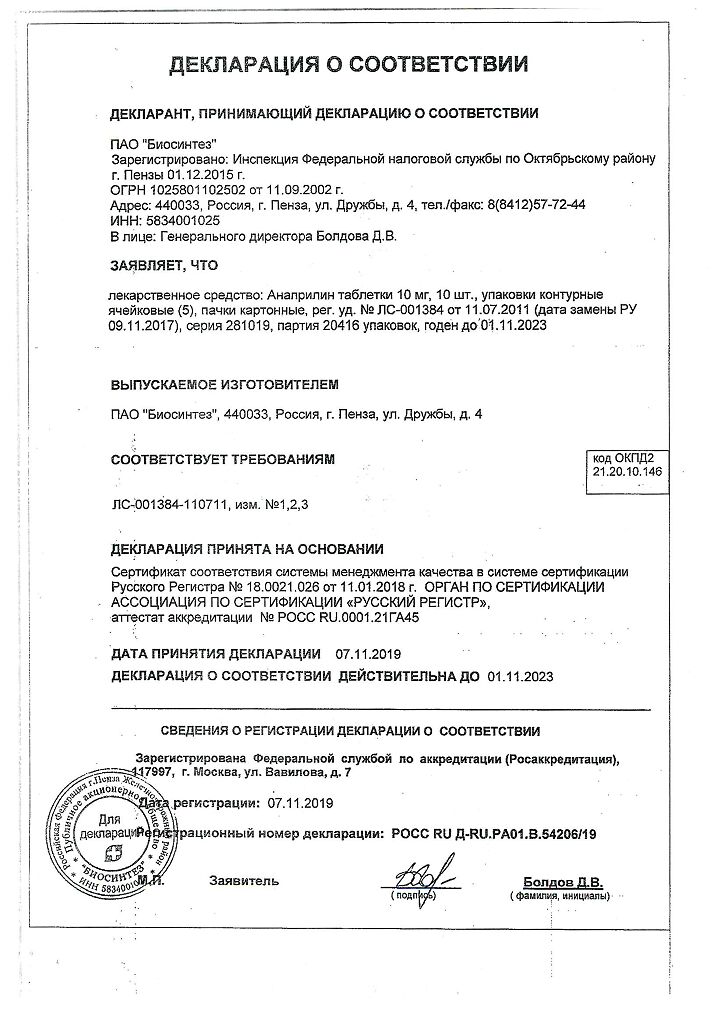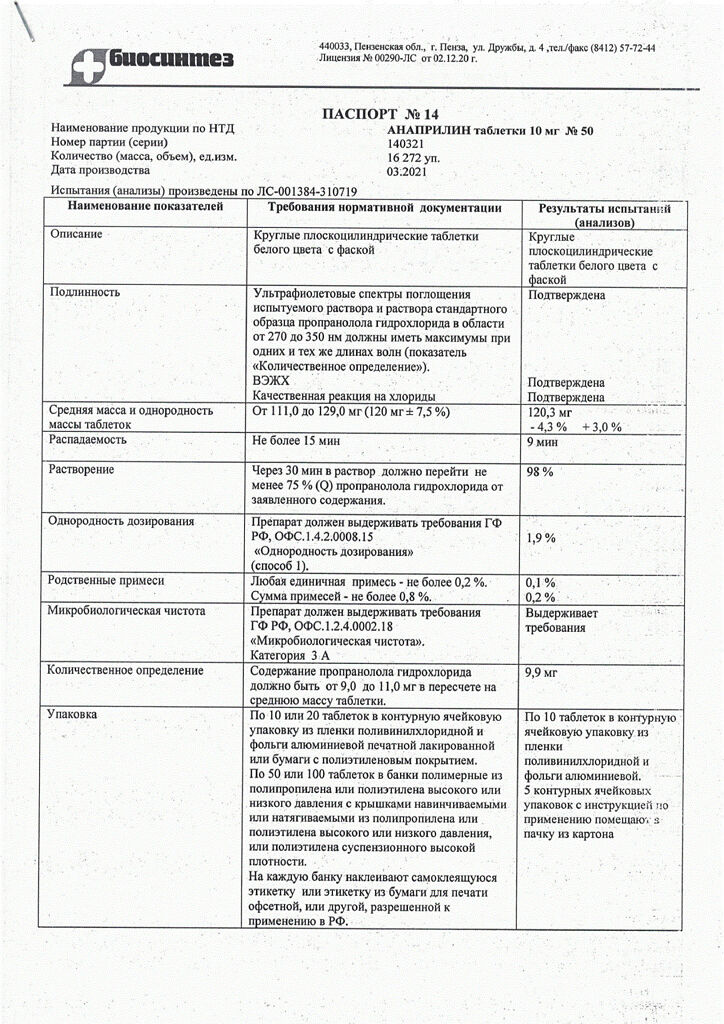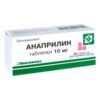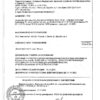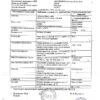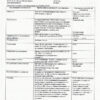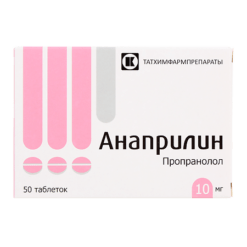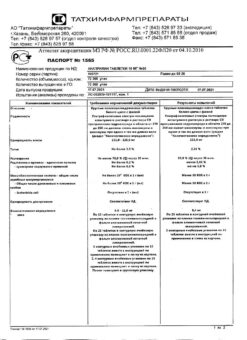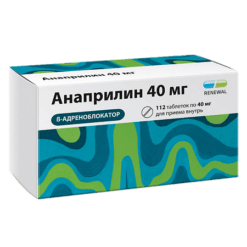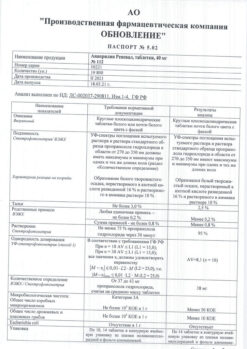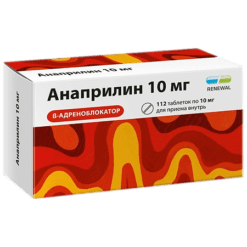No products in the cart.
Anaprilin, tablets 10 mg 50 pcs
€0.68 €0.62
Description
Hypertension (high blood pressure), Arrhythmia, Shortness of breath, Angina
Indications
Indications
Arterial hypertension, exertional angina, unstable angina, sinus tachycardia (including with hyperthyroidism), supraventricular tachycardia, atrial fibrillation, supraventricular and ventricular extrasystole, prevention of myocardial infarction (systolic blood pressure – more than 100 mm Hg), pheochromocytoma, essential tremor, migraine (prevention of attacks), as an adjuvant in the treatment of thyrotoxicosis and thyrotoxic crisis (in case of intolerance to thyreostatic drugs), sympatho-adrenal crises against the background of diencephalic syndrome.
Pharmacological effect
Pharmacological effect
Pharmacokinetics
It is quickly and fairly completely (90%) absorbed when taken orally and is relatively quickly eliminated from the body. Bioavailability after oral administration is 30–40% (the “first pass” effect through the liver, microsomal oxidation), with long-term use it increases (metabolites that inhibit liver enzymes are formed), its value depends on the nature of the food and the intensity of hepatic blood flow. Metabolized by glucuronidation in the liver. The maximum concentration in blood plasma is achieved after 1–1.5 hours. It is highly lipophilic and accumulates in lung tissue, brain, kidneys, and heart. Penetrates through the blood-brain and placental barriers into breast milk. Communication with blood plasma proteins is 90–95%. Volume of distribution: 3–5 l/kg.
It enters the intestine with bile, is deglucuronidated and reabsorbed. The half-life is 3–5 hours; during a course of administration, it can be extended to 12 hours. Excreted by the kidneys—90%, unchanged—less than 1%. It is not removed by hemodialysis.
Pharmacodynamics
Non-selective beta blocker. It has antianginal, hypotensive and antiarrhythmic effects. By non-selectively blocking beta-adrenergic receptors (75% beta1‑ and 25% beta2‑adrenergic receptors), it reduces the formation of cAMP from ATP, stimulated by catecholamines, as a result of which it reduces the intracellular supply of calcium, has a negative chrono-, dromo-, batmo- and inotropic effect (reduces heart rate, inhibits conductivity and excitability, reduces myocardial contractility).
At the beginning of the use of beta-adrenergic blockers, the total peripheral vascular resistance increases in the first 24 hours (as a result of a reciprocal increase in the activity of alpha-adrenergic receptors and the elimination of stimulation of beta2-adrenergic receptors in the vessels of skeletal muscles), but after 1-3 days it returns to the original level, and with long-term administration it decreases.
The hypotensive effect is associated with a decrease in cardiac output, sympathetic stimulation of peripheral vessels, a decrease in the activity of the renin-angiotensin system (important in patients with initial hypersecretion of renin), the sensitivity of the aortic arch baroreceptors (there is no increase in their activity in response to a decrease in blood pressure) and an effect on the central nervous system. The hypotensive effect stabilizes by the end of 2 weeks of the course.
The antianginal effect is due to a decrease in myocardial oxygen demand (due to the negative chronotropic and inotropic effect). A decrease in heart rate leads to prolongation of diastole and improved myocardial perfusion. By increasing end-diastolic pressure in the left ventricle and increasing the stretch of ventricular muscle fibers, it can increase oxygen demand, especially in patients with chronic heart failure.
The antiarrhythmic effect is due to the elimination of arrhythmogenic factors (tachycardia, increased activity of the sympathetic nervous system, increased cAMP content, arterial hypertension), a decrease in the rate of spontaneous excitation of sinus and ectopic pacemakers and a slowdown of atrioventricular conduction. Inhibition of impulse conduction is observed predominantly in the antegrade and to a lesser extent in the retrograde directions through the atrioventricular node and along additional pathways. According to the classification of antiarrhythmic drugs, it belongs to group II drugs. Reducing the severity of myocardial ischemia – by reducing myocardial oxygen demand, post-infarction mortality can also be reduced due to the antiarrhythmic effect.
The ability to prevent the development of headaches of vascular origin is due to a decrease in the severity of dilation of cerebral arteries due to beta-blockade of vascular receptors, inhibition of platelet aggregation and lipolysis caused by catecholamines, a decrease in platelet adhesiveness, prevention of activation of blood coagulation factors during the release of adrenaline, stimulation of oxygen supply to tissues and a decrease in renin secretion.
The reduction in tremor with the use of propranolol may be due to the blockade of beta2-adrenergic receptors. Increases the atherogenic properties of blood. Strengthens uterine contractions (spontaneous and caused by drugs that stimulate the myometrium). Increases bronchial tone.
Special instructions
Special instructions
Monitoring of patients taking Anaprilin should include monitoring of heart rate and blood pressure (at the beginning of treatment – daily, then once every 3-4 months), ECG.
In elderly patients, it is recommended to monitor renal function (once every 4–5 months).
If elderly patients develop increasing bradycardia (less than 50 beats/min), arterial hypotension (systolic blood pressure less than 100 mm Hg), atrioventricular block, bronchospasm, ventricular arrhythmias, severe impairment of liver and/or kidney function, it is necessary to reduce the dose of the drug or discontinue treatment.
The patient should be taught how to calculate heart rate and instructed about the need for medical consultation if the heart rate is less than 50 beats/min.
It is recommended to discontinue therapy if depression caused by taking beta-blockers develops.
Patients using contact lenses should take into account that during treatment the production of tear fluid may decrease.
Before prescribing Anaprilin, patients with heart failure (early stages) must use digitalis and/or diuretics.
Treatment of coronary heart disease and persistent arterial hypertension should be long-term – taking Anaprilin is possible for several years.
Discontinuation of treatment is carried out gradually, under the supervision of a physician: abrupt withdrawal can dramatically increase myocardial ischemia, anginal syndrome, and worsen exercise tolerance.
Cancellation is carried out gradually, reducing the dose over 2 weeks or more (reduce the dose by 25% every 3-4 days).
In patients with diabetes mellitus, the drug is used under the control of blood glucose levels (once every 4–5 months).
In case of thyrotoxicosis, Anaprilin can mask certain clinical signs of hyperthyroidism (for example, tachycardia). Abrupt withdrawal in patients with thyrotoxicosis is contraindicated, as it can intensify symptoms. When prescribing beta-blockers to patients receiving hypoglycemic drugs, caution should be exercised, since hypoglycemia may develop during prolonged breaks in food intake. Moreover, its symptoms such as tachycardia or tremor will be masked due to the action of the drug. Patients should be instructed that the main symptom of hypoglycemia during treatment with beta-blockers is increased sweating.
Prescribe with caution in combination with hypoglycemic agents (the risk of hypoglycemia during insulin therapy and hyperglycemia during oral hypoglycemic agents).
When taking clonidine simultaneously, it can be discontinued only a few days after Anaprilin is discontinued.
For pheochromocytoma, it is prescribed only in combination with alpha-blockers.
If necessary, use during pregnancy, which is possible only if the benefit to the mother outweighs the risk of side effects in the fetus and child. If it is necessary to take it during pregnancy, careful monitoring of the condition of the fetus 48–72 hours before birth should be discontinued.
Do not use simultaneously with antipsychotic drugs (neuroleptics) and tranquilizers.
Drugs that reduce catecholamine reserves (for example, reserpine) can enhance the effect of beta-blockers, so patients taking combinations of drugs should be under constant medical supervision to detect arterial hypotension and bradycardia.
During treatment with Anaprilin, intravenous administration of verapamil and diltiazem should be avoided.
Use with caution in combination with psychotropic drugs, for example, MAO inhibitors, when used for a course of more than 2 weeks.
A few days before general anesthesia with chloroform or ether, it is necessary to stop taking the drug (increased risk of depression of myocardial function and the development of arterial hypotension).
During the treatment period, it is necessary to refrain from driving vehicles and engaging in potentially hazardous activities that require increased concentration and speed of psychomotor reactions.
In smokers, the effectiveness of beta-blockers is lower.
During treatment, it is not recommended to take ethanol (a sharp decrease in blood pressure is possible).
The drug should be discontinued before testing the content of catecholamines, normetanephrine and vanillylmandelic acid in the blood and urine; antinuclear antibody titers.
Avoid using natural licorice during treatment; Protein-rich foods can increase bioavailability.
Active ingredient
Active ingredient
Propranolol
Composition
Composition
1 tablet contains:
Active substance
Propranolol hydrochloride (anaprilin) 10 mg.
Excipients
Lactose (milk sugar), potato starch, calcium stearate.
Contraindications
Contraindications
Hypersensitivity to the drug, atrioventricular block II–III degree, sinoauricular block, sinus bradycardia, arterial hypotension, uncontrolled chronic heart failure IIB–III degree, acute heart failure, acute myocardial infarction (systolic blood pressure less than 100 mm Hg), cardiogenic shock, pulmonary edema, sick sinus syndrome, Prinzmetal’s angina, cardiomegaly (without signs of heart failure), vasomotor rhinitis, occlusive diseases of peripheral vessels, diabetes mellitus, metabolic acidosis (including diabetic ketoacidosis), bronchial asthma, a tendency to bronchospastic reactions, chronic obstructive pulmonary disease (including a history), pheochromocytoma (without simultaneous use of alpha-blockers), spastic colitis, concomitant use with antipsychotics and anxiolytics (chlorpromazine, trioxazine, etc.), MAO inhibitors, lactation period, age up to 18 years (efficacy and safety have not been established).
With caution – liver and/or renal failure, hyperthyroidism, myasthenia gravis, heart failure, pheochromocytoma, psoriasis, pregnancy, history of allergic reactions, Raynaud’s syndrome, old age.
Side Effects
Side Effects
From the cardiovascular system: sinus bradycardia, atrioventricular block, heart failure, palpitations, myocardial conduction disturbances, arrhythmias, decreased blood pressure, orthostatic hypotension, chest pain, spasm of peripheral arteries, cold extremities.
From the digestive tract: dry mouth, nausea, vomiting, diarrhea, constipation, pain in the epigastric region, impaired liver function, change in taste.
From the nervous system: rarely – headache, insomnia, nightmares, asthenic syndrome, decreased ability for rapid mental and motor reactions, agitation, depression, paresthesia, increased fatigue, weakness, dizziness, drowsiness, confusion or short-term memory loss, hallucinations, tremor.
From the respiratory system: rhinitis, nasal congestion, shortness of breath, bronchospasm, laryngospasm.
Metabolism: hypoglycemia (in patients with type I diabetes mellitus), hyperglycemia (in patients with type II diabetes mellitus).
From the senses: dryness of the mucous membrane of the eyes (decreased secretion of tear fluid), impaired visual acuity, keratoconjunctivitis.
From the reproductive system: decreased libido, decreased potency.
From the skin: alopecia, exacerbation of psoriasis, increased sweating, skin hyperemia, exanthema, psoriasis-like skin reactions.
From the endocrine system: decreased thyroid function.
Allergic reactions: skin rash, itching.
Laboratory indicators: agranulocytosis, increased activity of “liver” transaminases and bilirubin levels.
Effect on the fetus: intrauterine growth retardation, hypoglycemia, bradycardia.
Other: muscle weakness, back or joint pain, chest pain, leukopenia, thrombocytopenia and withdrawal syndrome.
Interaction
Interaction
The hypotensive effect of propranolol is enhanced when combined with diuretics, reserpine, hydralazine and other antihypertensive drugs, as well as ethanol.
The hypotensive effect is weakened by non-steroidal anti-inflammatory drugs (sodium retention and blocking prostaglandin synthesis by the kidneys), estrogens (sodium retention) and MAO inhibitors.
Cimetidine increases bioavailability.
Increases the concentration of lidocaine in the blood plasma, reduces the clearance of theophylline.
Co-administration with phenothiazine derivatives increases the concentrations of both drugs in the blood plasma.
Enhances the effect of thyreostatic and uterotonic drugs; reduces the effect of antihistamines.
Increases the likelihood of developing severe systemic reactions (anaphylaxis) due to the introduction of allergens used for immunotherapy or for skin testing.
Amiodarone, verapamil and diltiazem – increased severity of the negative chrono-, ino- and dromotropic effects of propranolol.
Iodine-containing radiocontrast drugs for intravenous administration increase the risk of anaphylactic reactions.
Phenytoin when administered intravenously, drugs for inhalation general anesthesia (hydrocarbon derivatives) increase the severity of the cardiodepressive effect and the likelihood of lowering blood pressure.
Changes the effectiveness of insulin and oral hypoglycemic drugs, masks the symptoms of developing hypoglycemia (tachycardia, increased blood pressure).
Reduces the clearance of xanthines (except difillin).
The hypotensive effect is weakened by glucocorticosteroids.
Cardiac glycosides, methyldopa, reserpine and guanfacine, antiarrhythmic drugs increase the risk of developing or worsening bradycardia, atrioventricular block, cardiac arrest and heart failure.
Nifedipine can lead to a significant decrease in blood pressure.
Prolongs the effect of non-depolarizing muscle relaxants and the anticoagulant effect of coumarins.
Tri- and tetracyclic antidepressants, antipsychotic drugs (neuroleptics), ethanol, sedatives and hypnotics increase CNS depression.
Concomitant use with MAO inhibitors is not recommended due to a significant increase in the hypotensive effect; the break in treatment between taking MAO inhibitors and propranolol should be at least 14 days.
Non-hydrogenated ergot alkaloids increase the risk of developing peripheral circulatory disorders.
Sulfasalazine increases the concentration of propranolol in the blood plasma (inhibits metabolism), rifampicin shortens the half-life.
Overdose
Overdose
Symptoms: bradycardia, dizziness or fainting, decreased blood pressure, arrhythmias, difficulty breathing, cyanosis of fingernails or palms, or convulsions.
Treatment: gastric lavage, administration of activated charcoal, if atrioventricular conduction is impaired, 1–2 mg of atropine, epinephrine are administered intravenously; if efficiency is low, a temporary pacemaker is installed; for ventricular extrasystole – lidocaine (class IA drugs are not used); for arterial hypotension, the patient should be in the Trendelenburg position. If there are no signs of pulmonary edema, plasma-substituting solutions are administered intravenously; if ineffective, epinephrine, dopamine, dobutamine are administered; for convulsions – intravenous diazepam; for bronchospasm, beta-agonists are inhaled or parenterally.
Storage conditions
Storage conditions
Store in a dry place, protected from light.
Keep out of the reach of children.
Shelf life
Shelf life
4 years.
Do not use the drug after its expiration date.
Manufacturer
Manufacturer
Biosynthesis, Russia
Additional information
| Manufacturer | Biosintez, Russia |
|---|---|
| Medication form | pills |
| Brand | Biosintez |
Other forms…
Related products
Buy Anaprilin, tablets 10 mg 50 pcs with delivery to USA, UK, Europe and over 120 other countries.


